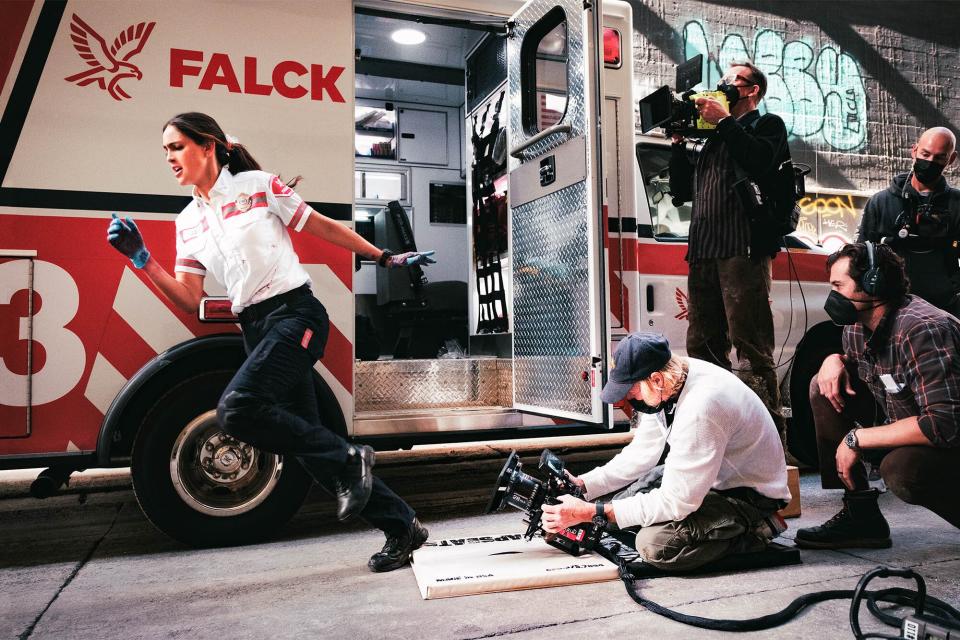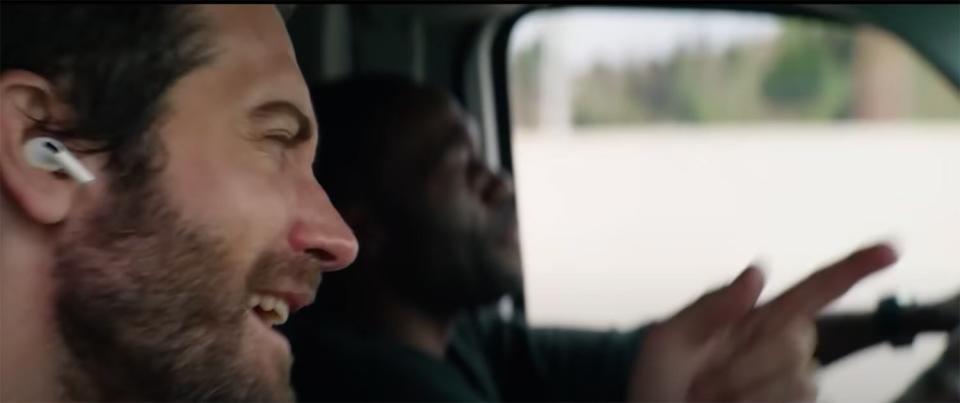How realistic is Eiza Gonzalez's Ambulance character? We asked an L.A. paramedic
Warning: This article contains spoilers for the new Michael Bay movie Ambulance.
In Michael Bay's high-concept action thriller Ambulance, Eiza Gonzalez stars as Cam, an unflappable paramedic who completes increasingly ludicrous medical feats while held hostage in the back of an emergency vehicle hijacked by bank-robber brothers Danny (Jake Gyllenhaal) and Will (Yahya Abdul Mateen II). How ludicrous? We asked UCLA Paramedic Program Director David Filipp whether Cam's actions are heretical — or actual health care.
ENTERTAINMENT WEEKLY: There's a scene where one of the characters gets shot in the chest and Cam performs CPR on him. Can you do CPR on someone who's been shot in the chest or does that move things around too much?
DAVID FILIPP: No, actually CPR is all you really can do. If someone's in a position where their heart's not beating, regardless of the reason their heart's not beating, you have to do CPR. They don't have a pulse at that point in time, so they're dead if you don't do it.
That won't push more blood out or anything?
Whether it's a car accident or a gunshot or a heart attack, if their heart's not beating, their heart's not beating. And the only way we have to do that is to artificially make the heart pump, which is through CPR.

Andrew Cooper/Universal Pictures Eiza Gonzalez and Michael Bay on the set of 'Ambulance'
There's another scene in which the paramedic, Cam, has to perform surgery to remove a bullet from a victim while in a speeding ambulance. She FaceTimes a bunch of doctors on her computer and they guide her through it. Is that even possible?
Telemedicine has been around on ambulances in some locations around the U.S. for several years. The city of San Antonio experimented with that several years ago — an ER doctor could actually see the patient in the back of the ambulance and provide some guidance to the paramedics. But having a physician talking a paramedic through surgery would be extraordinarily unlikely.
Especially not during a high-speed car chase.
No. And frankly, we're moving a bullet. It might cause additional bleeding. So that probably wouldn't be something we would do — it's a little beyond our scope as paramedics. Even with the doctor's instruction, we couldn't do that.
In the movie, the paramedic actually pulls out someone's spleen because a bullet is lodged there. But the spleen bursts. If someone's whole torso is open because they just had their spleen manually removed, can that someone survive?
Spleen injuries are actually fairly common in trauma patients. If you're impacted on the left by a car accident or a bullet or a knife wound or whatever, your spleen can be damaged. And it's full of blood and bleeds a lot. So trauma surgeons often remove spleens to help a trauma patient survive a really bad accident. Paramedics wouldn't remove the spleen, but a trauma surgeon would certainly consider it if the spleen bleeding couldn't be controlled. And you can live without a spleen.
Good point. Would a paramedic be able to stitch up somebody who just had their spleen removed in the back of an ambulance?
Some paramedics who work offshore in extremely rural areas where there isn't a medical facility close might have a higher scope of practice where they can suture people up, but it wouldn't generally be internal stitching.

Universal Pictures Eiza Gonzalez in Michael Bay's 'Ambulance'
I guess it would just be the outside stuff. But let's say that's not the case and it's internal stitching like what obviously would be needed here. Is that person a goner or is it survivable?
Time is really the factor. If we can get them to a trauma surgeon within about an hour, their chances of survival are much, much better. The longer it is until they get to a surgeon, the less chance of survival they will have.
Oh, yes, Cam says that. She tries to get everyone to the hospital in under a certain number of minutes.
Absolutely. There was a concept of the golden hour, which is from the time of injury until the time that person reaches a surgeon's table. And if they can't reach it within an hour, their chances of survival drop dramatically. But as paramedics, we don't have a golden hour — we have a platinum 10 minutes to assess them and get them on the way.
Have you ever had a spleen burst in your hands?
Oh, no. Well, I've had plenty of patients who've had ruptured spleens. Again, that's not terribly unusual with a trauma patient, but we're not going to open somebody up and stick our hands in their belly to hold their spleen. That's just not something paramedics do.
Well, they do it in this movie.
Of course they do.
Because this guy's losing so much blood, Cam hooks one of the drivers up to donate blood while he's driving, because he's O positive, and I guess that's the blood type that can go to anybody?
O negative, actually.

Universal Pictures Jake Gyllenhaal and Yahya Abdul Mateen II in 'Ambulance'
Okay, O negative. So is that possible? If someone's driving, can you hook them up to an IV and then hook it up to somebody in the back to give them blood?
No, it's not. There are multiple other things needed for blood to be properly matched to people. It isn't just about type. And we wouldn't transfer somebody, especially somebody who's driving because if you've ever given blood, you [know you] can get lightheaded. So with all these lives at stake in the back, to be driving and giving blood at the same time… yeah, no. It makes for a great story, but it's not realistic.
Just a couple of more factual things. Is a butterfly hair clip a usable clamp for an artery that's bleeding out?
If you have a blood vessel bleeding, you have to do what you can to stop the bleeding. We have medications that can help with that, or we have tourniquets that obviously we use instead, but the point is to stop the bleeding at that point in time. So I suppose [a hair clip] could be used.
But if the paramedic has to stitch the person up, would she stitch the hair clip into them?
They would have to stop the bleeding and the stitching would be a secondary consideration. That's just a wound closure. So stitching the wound up wouldn't be a big concern. Stopping the bleeding would be a big concern.
So you can ostensibly, in the chain of importance, leave the clip in there?
Oh yeah. You got to stop the bleeding first.
Can an ambulance withstand gunshots from the outside?
It kind of depends on the caliber of gun being used. You have lower-velocity guns, like handguns, where [the ambulance] may be able to withstand that. But a high-velocity gun like a deer rifle, that may penetrate the back of the ambulance. It also depends on where the ambulance sustains the gunshot because parts of it are thinner than other parts. So it probably could to some extent. I've been shot at in the ambulance as well.
Oh my god.
We heard it, but the bullet didn't come inside. So it just depends on where on the ambulance it actually occurs.
Last question — a personal one for you: Let's say you've had a very traumatic day. Are you able to turn it off? Or can you go have enchiladas after?
I think that's an excellent point because one of the things we really worry about now is the stress on the providers. One of the tough parts is we don't get any real follow-up on our patients. We care for them in the ambulance, and they're left at the hospital, and we don't really have a way to circle back and go, "Hey, how did he do?" Or "How did she do?" We don't really have any closure from those encounters. I've been in EMS for 40 years; I've been a paramedic 38 of those years. I've developed coping mechanisms to where you can kind of turn it off when you need to turn it off.
Ambulance is in theaters now.
This interview has been edited and condensed for length and clarity.
Want more movie news? Sign up for Entertainment Weekly's free newsletter to get the latest trailers, celebrity interviews, film reviews, and more.
Related content:

